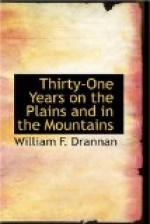He told me that although isolated from the world, he was doing well, from the fact that most all of the people passing there patronized him. This family was from Indiana. After I had told him who I was and what would be my business, he insisted on my staying over night with him when convenient, saying that it would not cost me a cent. Thanking him for his hospitable offer, we rode on, keeping the Butterfield route. Late that afternoon we met a train of sixteen wagons on the way to California. The people told us that the day before they had seen where five wagons had just been burned. I asked how far it was, and they thought it was twenty-five miles from where we met them. When we heard of this we pushed on, thinking there might be some dead bodies there and that we could bury them. On arriving at the scene, sure enough we found three dead bodies two hundred and fifty yards from the burned wagons; one of them being that of an old man, and the others, two boys twelve and fourteen years of age. The Indians had not stripped the bodies nor mutilated them, only they were all filled with arrows. The dead bodies were all dressed in home-made jeans. We found a few pieces of wagon boxes that had not been burned and dug as good a grave as we could in the sand, giving them as good a burial as we could under the circumstances. This being done, we took the trail of the Indians, which led off in a south-westerly direction. I felt confident that it had been at least three days since this depredation had been committed. My object in following them up was to see if we could get any evidence of white prisoners in their camp. For the first ten or fifteen miles they kept on the roughest, rockiest ground they could find, all of which led me to believe they had expected to be followed. The next morning we came to where they had made their first camp. All the evidence we could see of white prisoners in their charge was a few pieces of calico torn up and scattered around their camp-ground. We followed the trail until we came to where they had made their second camp, and here we found the waists of two women’s dresses, one being somewhat larger than the other. The two dress waists we took along with us. Here the Indians had changed their course somewhat, and our guide said in the direction of their main village, but I did not consider myself well enough posted to go too near their main village. I told the guard to lead us off south of west from Fort Yuma, which he did, and late that afternoon we saw six Indians traveling east, and I told the boys that they were scouts for the main band and that they were going out to look for emigrants. When we first got sight of them they were traveling up an open valley. I told the boys that we would keep a close watch of them, and if they should camp alone we would have their scalps before morning; but just one look from Freeman and I was convinced that he did not approve of this scheme. George said to him:




